2024 ITG Conference Report - Day 4 - Friday, May 31
The 48th Annual International Trumpet Guild Conference - Anaheim, California (USA)
Special Daily Report • Compiled by Peter Wood
Photos by Michael Anderson, Jason Harrelson, Daniel Kelly, and Steve Stricker
Friday, May 31, 2024
Click here for more photos from the ITG Conference
Ryan Stransky Youth Warm-Up Session - The Routine 30 Minutes for YOU!
Dr. Ryan Stransky, instructor of brass at Alcorn State University, presented his first-ever session at the ITG Conference, kicking off the Youth Extravaganza weekend. His “Routine-30 Minutes for YOU!” explored how a warm-up routine can be structured to fit personal daily needs both mentally and physically. With the individual in mind, Stransky’s routine offers a creative and organized way to build and set small goals. He demonstrated a step-by-step guide to building an effective routine that utilizes breathing, buzzing, flow studies, and fundamentals. To end the routine, Stransky encouraged everyone to work on etudes to incorporate every building block at once. Stransky’s overall focus is on developing individuals, and that can involve a variety of combinations and methods. (Madison Barton)
Jason Dovel Non-Pro Players Warm-Up Session
In Dr. Jason Dovel’s session for the non-pro players, a full room of trumpeters received valuable insights into how warmups can provide a foundation for improvement and increase accuracy in one’s overall playing. Dovel shared exercises from his routine, taking the players through key exercises that he incorporates daily. His approach involves helping the trumpeter establish good habits and unlearn bad habits while working on accuracy. Dovel emphasized the importance of practicing throughout the full range and dynamic spectrum of the instrument each day in the warmup. Ultimately, each concept mentioned in the session encourages participants to “warm up for tomorrow, not today,” which will foster quicker improvement. Trumpeters in attendance are sure to benefit from Dovel’s sound principles of warming up and now have excellent exercises to incorporate into their daily warm up session. (Sarah Stoneback)
Adán Delgado Warm-Up Session - Organizing Your Body and Mind with Balance and Common Sense
Spanish trumpet soloist Adán Delgado began the warm-up session by playing descending long tones, Cichowicz flow study patterns, and an expanding G-major scale, inviting the more than sixty attendees to copy his playing. Delgado explained that an effective warmup sets up good breathing and a relaxed posture. He pointed out that if one knows what is important, it is possible to adapt any method to suit one’s individual needs. Finally, he closed the session by demonstrating effective slur patterns. (Stanley Curtis)
Josh Rzepka - Mastering Mutes
Selecting the right mute for the job is important, and Josh Rzepka offered a wealth of information in this well-attended session. With a tremendous number of mutes laid out, guests were surely in for a treat. Rzepka began by addressing the most vital qualities that a player should analyze when choosing the right mute: core, projection, articulation, response, tonal color, and intonation. Rather than asking which mute to choose, players must consider their circumstances: their role within the ensemble or composition, the size of the venue, the acoustic layout, and other demands of whatever job they are playing. The session continued with helpful tips and tricks, such as filing your corks down - because not all bell flares are created equal! Lastly, Rzepka brought a group of players to the stage to demonstrate some classical and jazz excerpts, each time repeated with a mute consisting of different material and design than the one before. (Peter Nionakis)
Youth Competition: Senior Division
The finals of The Ryan Anthony Memorial Trumpet Competition, senior youth division, featured sixteen finalists from across the globe performing a variety of etudes and solos, including works by Charlier and Brandt. David Zhao was the first contestant, performing Charlier #10 with clear style and great pacing through many of the etude’s intervallic challenges. The second finalist, Emily Ayala, performed a Vannetelbosch etude with strong, contrasting dynamics and infectious energy. Leon Ye demonstrated a clear, beautiful tone and good musicianship in his performance of Charlier #2. The fourth contestant, Christian Garner, displayed great ease of playing in Charlier #6, highlighting great dynamics and a resonant sound. Hsueh-Yang Yang performed the technical passages of Charlier #23 with ease and a clear sound in all registers. Stefan Gjorgiev performed Charlier #2, displaying a beautiful vibrato with great pacing and style. Joshua Tan chose to perform Brandt #23, highlighting great dynamic contrast throughout. Natasha Hernandez played selections from the Neruda Concerto, representing great tone and phrasing.
Following a short break, Yinglu Liu began the second half with a performance embodied by finessed technical playing and clear articulation. Soren Hershkowitz demonstrated an ease of playing and vibrant tone in his rendition of Charlier #4. Marshall Lin displayed a strong command of the technical elements, and a full beautiful sound in his performance. Owen Kearney performed Charlier #6 with terrific dynamic contrast and a resonant tone. Yuntong Li did a wonderful job with Charlier #24, channeling the drama and the passion of the Wagner operas. Daniel Lee showed off his great sound and musical pacing throughout his performance. Sean Kobayashi played Charlier #2 with strong timing and great flexibility throughout all registers. The final contestant was Andy Hao, performing Charlier #6 with beautiful tone in both technical and lyrical passages. All of these finalists demonstrated great passion and joy in their performances. (Flint Angeroth Franks)
Jason Dovel Non-Pro Masterclass - Trumpet Rules of Thumb
Jason Dovel gave an impressive and informative masterclass for non-pro trumpeters after his 8:30 a.m. warm-up class. Dovel included tips and tricks, his “Rules of Thumb” for embouchure, tempo, intonation, endurance, phrasing, breathing efficiency, and “unbreaking” bad habits. Two concepts that serve as cornerstones in his teaching are embouchure and endurance. Regarding embouchure, he shared, “Mouthpiece pressure is not the ‘boogeyman;’ rather, where the pressure is being applied is the boogeyman.” He stressed the importance of more pressure being distributed on the bottom lip than on the top lip. Endurance is helpful to think about as a budget – how much does it “cost” you for each note you play?Three non-pro trumpeters performed for Dovel, and all demonstrated marked improvement after receiving Dovel’s useful advice. The audience, including one person who was a friend and colleague of the legendary pedagogue Sigmund Hering, was very supportive and aided in great conversation. (Jacinda Ripley and Sarah Stoneback)
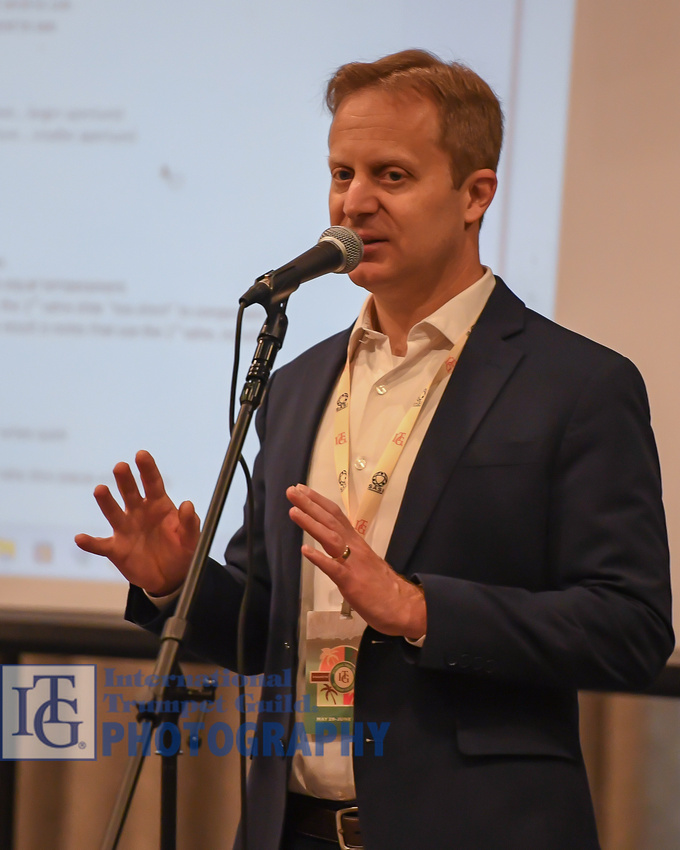

Micah Killion - Trumpet Practice Playbook: Quality vs. Quantity
In this session, Dr. Micah Killion described his valuable research on the importance of detailed practice vs. unfocused practice and on how we learn how to practice. Killion earned a PhD in Music and Human Learning from the University of Texas, and he encouraged detailed, focused work with healthy practice habits and mindsets. He also explained how these elements contribute to learning. He shared a short video clip of Master Sgt. Amy McCabe practicing and gave a real-time analysis of her effective process for addressing errors and solving problems in the practice room. Killion closed the session by sharing a link (https://umkc.co1.qualtrics.com/jfe/form/SV_6gwPFpeTDI9sD9s?Q_CHL=qr) to his study on how musicians learn about music practicing. (Madison Barton)
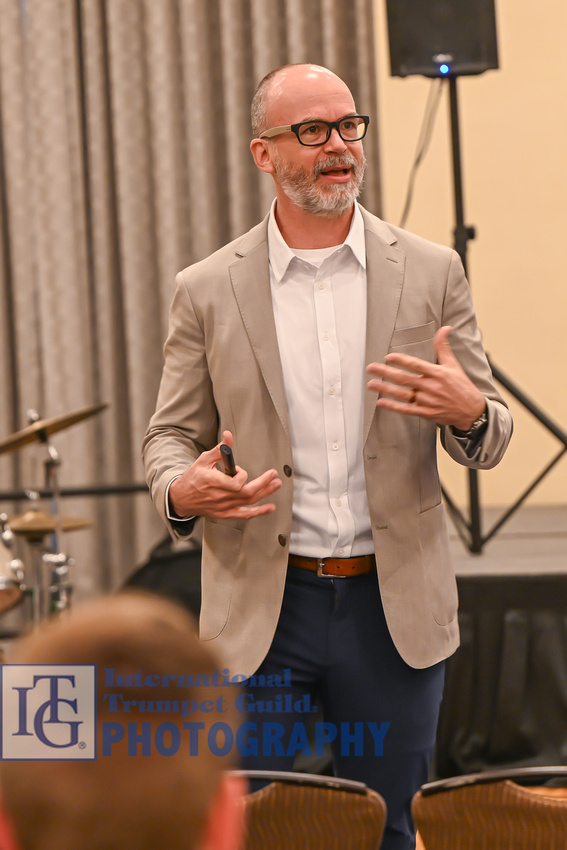

Rick Baptist - The Soundtrack of My Life in Hollywood
Recording over 1300 movies and thousands of TV shows, Rick Baptist is someone about whom most of us have heard at some time in our lives. His journey started when he was diagnosed with asthma as a child. To help improve his situation, the doctor recommended a wind instrument. That recommendation, along with the inspiration that Baptist gained from listening to Harry James, would be the catalyst for an astronomical career in music. His session was full of stories from as early as age twelve to the recording of the movie “Up,” in which a 1938 solotone mute would serve for the perfect character the composer was intending. Baptist discussed his mentors, early experience, and career highlights, and he sprinkled in advice to younger players. He expressed his fondness for playing music for cartoons. The insightful sessions ended with Baptist explaining that in 2020, he achieved the goal of having every musician receive mention in the ending credits for movies. (Will Koehler)


University Professor Spotlight Recital
Gabriel DiMartino, Michael Gause, Merrie Klazek, Mikio Sasaki, and Peydon Shelton
The Tennessee Tech University opened this new University Professor Spotlight Recital with an exciting performance of Doulas Hedwig’s “Brooklyn Fanfare” and Dennis Horton’s “Irish Folk Song Suite.” Peyden Sheldon performed Turrin’s “Three Excursions,” handling the technical demands with a bold, clear sound and crisp articulation. Michael Gause performed the third and fourth movements of Santiago Baez’s “Piezas Andaluzas.” The third movement features sinuous lines over a rhapsodic piano part, while the fourth is a rondo with an energetic, angular theme, all handled with ease by Gause. Mikio Sasaki presented Kenji Bunch’s “Tango Morendo,” with moments from lyrical to sultry and steamy, as well as a few quotes surely recognizable to listeners of a certain vintage. Sasaki concluded with a beautiful performance of “Flower of Patience,” a sweet, melancholic Japanese children’s folk song arranged by Tadaaki Ohno and edited by Timofei Dokshizer. Merrie Klazek performed three works from her latest album, featuring her own arrangements of music from around the globe. She opened on piccolo trumpet with an elegant and tastefully embellished performance of Jeremiah Clarke’s Minuet and Gigue. She switched to flugelhorn for Philippe Bruneau’s “La Complainte de la Folkloriste,” with the instrument providing dark undertones to Bruneau’s plaintive melodies. Klazek closed her performance with Astor Piazzolla’s beloved “Libertango.” Gabriel DiMartino closed the recital with the outer movements of Allen Vizzutti’s Sonata No. 2. DiMartino’s performance was spirited, clear, and quite exciting. The indefatigable Gail Novak accompanied all of the soloists with her customary grace and skill. (Daniel Kelly)
Brad Goode - Understanding Injury in Trumpet Players
In his highly informative presentation, Brad Goode clarified much of the confusing aspects of embouchure injuries. The highly accomplished jazz artist and professor from the University of Colorado Boulder suffered two accidents early in his career, which prompted decades of research into recovery and healthy embouchure training. Unlike muscles that are attached to bones, the orbicularis oris muscle responds differently to injury and requires special recovery. Goode explored symptoms and causes of muscle injury, as well as related nerve symptoms. He also demonstrated exercises developed by Dr. Simon McGrail, the Canadian surgeon who coined the term “Satchmo Syndrome,” referring to Louis Armstrong’s ruptured orbicularis oris. Goode made a plea for change; brass instructors need to change habits that make students susceptible to injury. One important factor in avoiding injury is engaging the buccinator muscles, which support the orbicularis oris and help to manage mouthpiece pressure. He was incredibly articulate and intentional in his remarks about a very sensitive subject. A common message to those struggling is: “It’s an injury, so you must treat it like an injury; but you’ll be fine.” (Nick Volz)
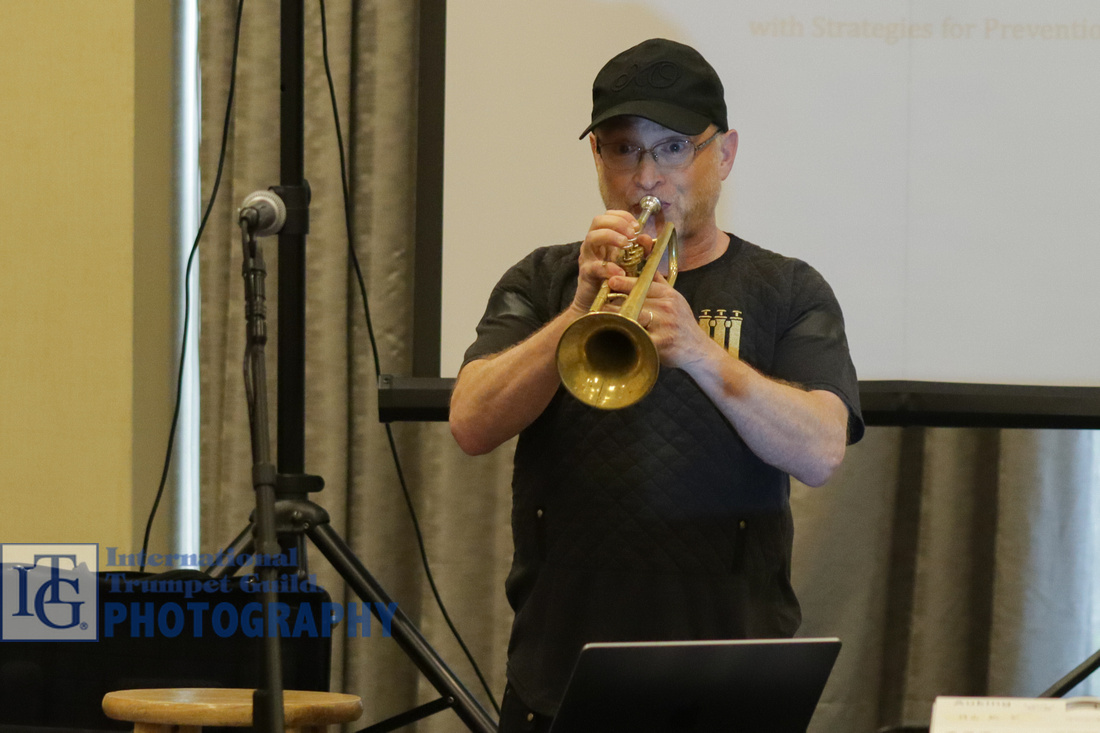

New Works Recital II
The Pre-Professional Quintet opened the New Works Recital with a strong performance of Connor Johnson’s trumpet ensemble piece “Spitballing,” which was an exciting work with a fiery opening, a soft lyrical section on flugelhorn, and a return to the fiery material to close.
The first piece on the second New Works Recital of the conference was the first movement of JaKobe Henry’s “American Dream,” titled “Chugga, Chugga, Chugga.” This crossover piece for trumpet and piano blended contemporary melodic figurations with jazz and blues-inspired tunes. Henry performed his own piece and had no difficulty navigating the changing styles.
Will Koehler performed the second and third movements, “Fugue” and “Toccata,” of Daixman Ai’s Sonata for Trumpet and Piano. The piece opens with piano figures emphasizing intervals of the fourth and fifth and is reminiscent of a gentler version of the Kennan Sonata sound world while also highlighting the tone colors of both the flugelhorn and trumpet.
Julia Bell performed the first movement, “With Bravery,” from Marcus Grant’s “Sonata for Heroes.” Bell’s clean performance showcased the heroic motives of the piece, which were evocative of any number of superhero movie themes cast in an accessible harmonic language. The limited range and technical demands would make it great for undergraduate students.
Elizabeth Raum composed “Illusion (Is the Better Part of Life)” for trumpet, trombone, and piano. Trumpeter Imani Duhe and trombonist Lori Stuntz performed the second and third movements with terrific expression, balance, and blend. The performance began with “Fill the Wine Cup,” a subdued march with an unrelenting ostinato in the piano, before moving on to the third movement, “Destiny,” which showcased drinking-song melodies weaving together humorous trumpet and trombone licks.
George Carpten, IV, performed Morgan Kelly Moss’s “To the Ones that Know My Heart.” The piece opened with floating atmospheric ideas in the piano while the trumpet part explored the full range and dynamic possibilities of the instrument, along with both muted and open tone colors. Carpten performed very expressively and cleanly with a clear and powerful tone throughout.
HyeKyung Lee’s “Endeavor” featured trumpeter Craig Parker, pianist HyeKyung Lee, and a vocalist who took the place of Elaine Huang, who was ill. The work featured repetitive ostinatos in the piano against muted figurations in the trumpet and wordless, quasi-improvisatory vocal figures sung with only syllables. Parker navigated the various tone colors of the solotone and wah-wah mutes to express the contemporary harmonic language and melodic phrase structures.
Brandon Dicks composed and performed the unaccompanied “Radiant Ascent.” The piece began with dark, atmospheric harmonies that gradually gave way to brighter ascending melodies, which Dicks performed with intense expression.
William Takacs performed BJ Brooks’s “Tau,” beginning with an arpeggiated ostinato in the piano with a Latin-flavored melody floating on top, interspersed with running flourishes. Takacs performed the piece with a musically clean and full tone, easily expressing the fast-moving tau proteins as they traverse vast neural networks in the brain.
John Mietus’s “Seraphim (robot with a human face)” began with a plaintive, yet sparkling, opening in the piano while the color pairing of oboe and trumpet created interesting musical colors. Tyler Helms kept the trumpet sound subdued while Ty Matthews performed the oboe strongly, resulting in a perfectly balanced performance in call-and-response motives.
Raquel Samayoa performed the final piece on the program, Tom Gontier’s “On the Road Up North.” The piece opens with an exciting, angular trumpet line that is cast against a dense, but accessible, piano part. Samayoa handled the many virtuosic passages and challenging multiple-tongued runs with ease. (Scott Hagarty)
Marco Pierobon Recital - Roma and New York (Ennio and George)
Opening for Marco Pierobon’s recital, the trumpet ensemble from the University of Wyoming performed Franz von Suppé’s very exciting “Poet and Peasant Overture” with great musicality and finesse. Pierobon’s first piece was a medley of works, entitled “Morricone Tribute.” This work consisted of an assortment of popular works by Morricone such as “Cinema Paradiso” and “The Good the Bad and The Ugly,” followed by another collection of popular tunes by Gershwin, with such notable melodies as “Fascinating Rhythm,” “I’ve Got Rhythm,” and “Rhapsody in Blue.” Pierobon’s stunning sound and ability to maneuver effortlessly around the instrument received him an enthusiastic standing ovation. He concluded his recital with a final medley of melodies from Gershwin’s “Porgy and Bess,” receiving a second standing ovation. Marco then left the audience with an encore. His recital demonstrated his unmatched musical abilities in all musical styles and genres, leaving him with a total of three standing ovations. (Maryna Pohlman)
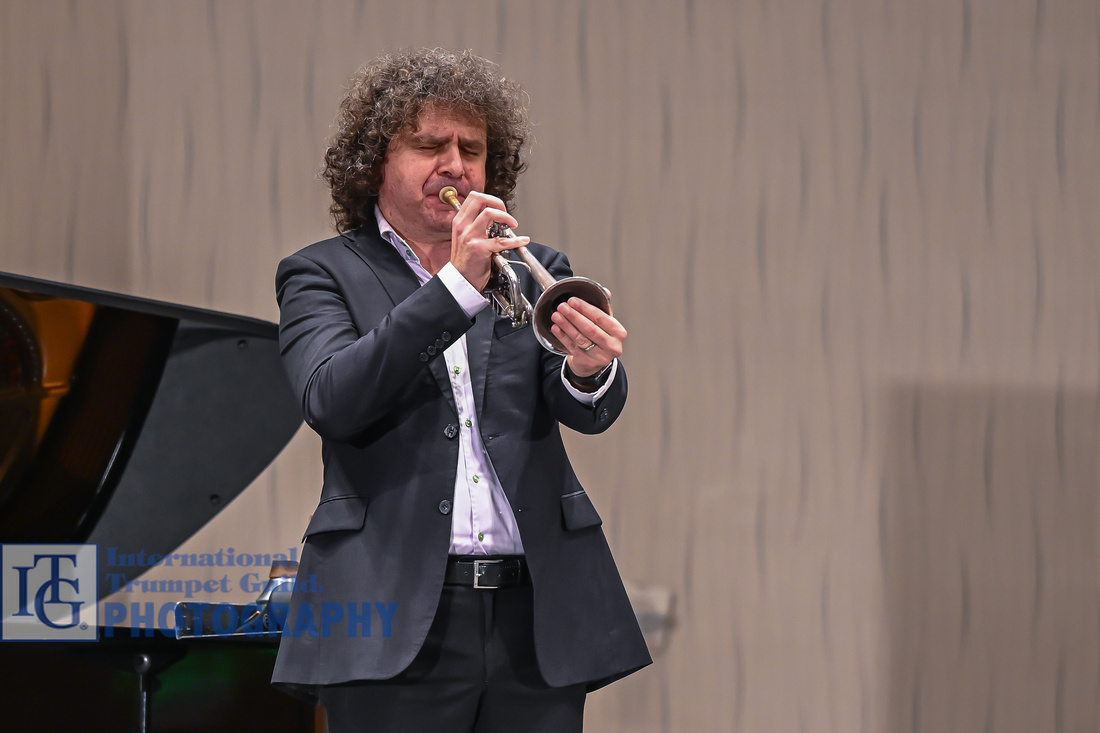

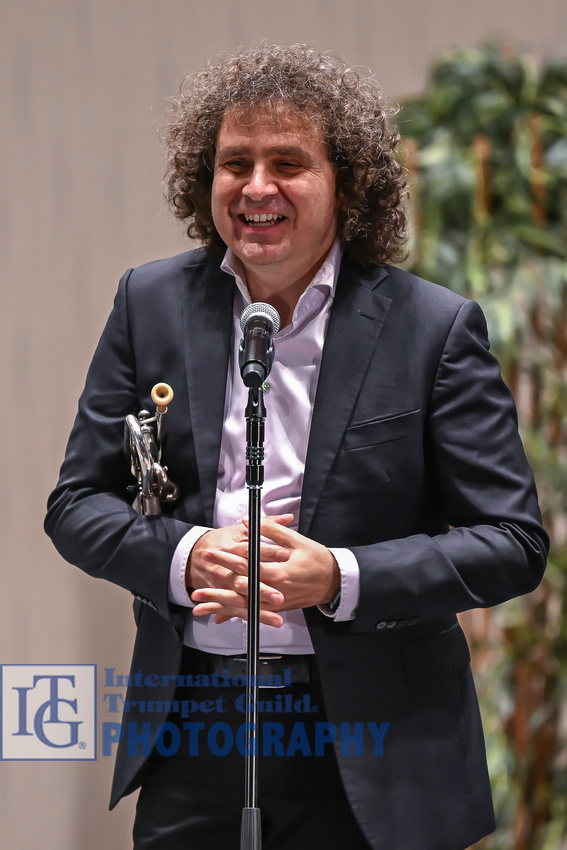

Youth Session with Imani Duhe
Atlanta native and current Los Angeles resident Imani Duhe presented a session as part of the Youth Extravaganza weekend. Her presentation was centered around developing good practice habits and making a career as a freelance artist. In addition to being an active performer, Duhe teaches for the Youth Orchestra of Los Angeles. With her experience in teaching younger performers, Duhe shared her idea of using vision boards to set short-term goals. Her vision-board model targets such areas as repertoire, technique, range, and personal goals and has a section dedicated to practicing for fun. She shared her intriguing journey to becoming a professional freelance artist. Duhe was an engaging and generous speaker and actively encouraged audience participation. (Madison Barton)
Brian Lynch - The Comprehensive Method for the Improvising Trumpeter
To open this session with Brian Lynch, the trumpet ensemble from Brigham Young University beautifully performed Erik Morales’s arrangement of “Amazing Grace.” In the session, Lynch, professor of studio music and jazz at the University of Miami Frost School of Music, described the method he uses with his students in Miami - a comprehensive approach for players who find that the standard technical studies, while helpful for trumpet technique, may not address all facets of their playing, especially improvisation. At its foundation is the Barry Harris method: thinking about melodies using specific eight-note scales (diminished/half-diminished). Lynch demonstrated ways to use these patterns, which incorporate lip bends, in developing flexibility, articulation, and high- and low-range development. His method should be available on his website (http://hollisticmusicworks.com) this fall. Aspiring improvisers will find many benefits to their playing as they apply these concepts. (Joseph Nibley)
David Wharton and Shawn Williams - Jazz Improv for Classical Players
Professors David Wharton and Shawn Williams held an active session about jazz improvisation for classical players. With Wharton’s classical background and William’s jazz background, they discussed the various ways that trumpeters can work on fundamentals while simultaneously incorporating foundational elements of jazz improvisation. They had the audience work on long tones by first singing the roots of the chord progression and then playing them, with the goal of getting the ears working while also focusing on sound production. In a similar fashion, attendees played a series of lip slurs over chord changes in various keys. Wharton would beautifully demonstrate the exercises for the audience while Williams expertly comped on the piano as well as excellently demonstrating on the trumpet. They also touched on flow studies (over a ii-V7-I progression and triads), range exercises over various chords, jazz articulations, and scales. (Randy Lee)
Anne McNamara - The History and Shared Experiences of Women and Non-Binary Trumpet Professors
Dr. Anne McNamara’s presentation began with a prelude performance by the University of Redlands trumpet ensemble, in which they played a David Hickman arrangement of Carlo Gesualdo’s madrigal “Moro lasso al mio duolo” and Erik Morales’s “Celestial Dance.” McNamara’s presentation was split into two portions: a history of women and non-binary trumpet professors and a summary of results from her qualitative survey of women and non-binary trumpet professors. This history highlighted achievements of women in trumpet teaching roles, such as Mabel Keith Leick, the first known woman trumpet professor, and Fay Hanson, the first full-time woman trumpet professor. In her survey, McNamara found an important statistic, showing that while there has been an increase in women and non-binary people as full collegiate professors, there has not been a significant difference in the challenges faced by current women and non-binary trumpet professors compared to retired professors. McNamara’s full findings can be found in recent volumes of the ITG Journal. (Flint Angeroth Franks)
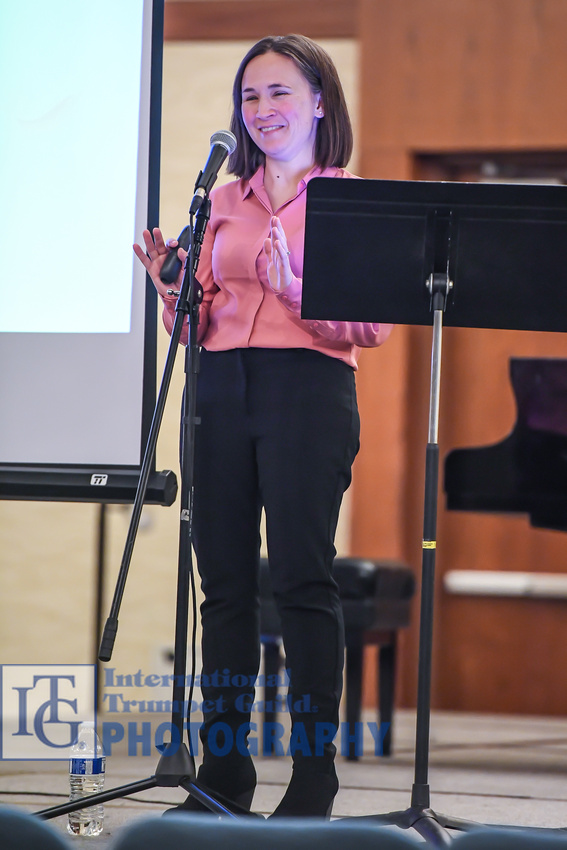

Solo Competition Finals
With a lively audience, a distinguished panel of judges, and three impeccably refined young trumpet players, there was never a dull moment during the final round of the solo division of The Ryan Anthony Memorial Trumpet Competition. Solo Competition Chair Andre Bonnici introduced each competitor, starting with Dylan Johnson from California State University. Johnson’s interpretation of Bozza’s “Rustiques” instantly established his exceptional musical maturity for conquering such a sophisticated piece of music. Attendees were captivated by his shimmering sound and in awe of his various facilities matched with beautiful vibrato.
Jiawei Chen from the Central Conservatory of China set the room ablaze with his bold and powerful take on the first movement of Tamberg’s Concerto op.42, utilizing a crisp tongue and flashy tone with highly contrasting dynamics. Chen’s brilliant sound was on full display on the concluding piece, “Song without Words” by Joel Collier, where Chen was fully immersed in the music and displayed a variety of color and character throughout.
Raphaël Horrach, from the Lyon Superior Conservatory in France, opened his portion of the competition with J. Hertel’s Concerto No. 1 in E-flat Major, consisting of a most delicate, yet commanding, tone. Filled with mesmerizing ornamentation and impressive moments of effortless extreme register, Horrach used the piccolo trumpet as an extension to represent his extraordinary musical abilities. He transitioned very well to C trumpet for the “Sarabande et Finale” by Gallois-Montbrun, elegantly moving through the work’s difficult passages. Accompanist Gail Novak showcased phenomenal musicianship, virtuosity, and excellent collaboration with all three of these fine players. This reporter was highly impressed that all candidates came sharply dressed and held great poise during each of their performances. (Peter Nionakis)
Evening concert: Håkan Hardenberger and Roland Pontinen
To characterize the Friday night concert as “much anticipated” would be a gross understatement. The legendary Håkan Hardenberger rarely gives recitals these days, and his visits to the US are rarer still. This concert was, for most of us, a once-in-a-lifetime event! The prelude ensemble was no less impressive. The trumpet ensemble from the Conservatoire National Superieur de Lyon opened with a treacherous arrangement of the well-known Toccata from Widor’s Fifth Organ Symphony, which they handled with ease, particularly the abundant piccolo parts. The next selection was a clever and quite challenging mashup of 22 melodies or motifs from Maurice André’s more famous recordings. Quotes from Hummel, Chaynes, Tomasi, and several Baroque works were heard. As one would expect from the Lyon Conservatory, the ensemble was absolutely on point.
Following the prelude, awards for two competitions were announced. ITG Youth Competition Chair Erika Izaguirre announced the winners of the Youth Senior Division of The Ryan Anthony Memorial Trumpet Competition. The third-place finisher was Stefan Gjorgiev. Second place was awarded to Yinglu Liu. The first prize was awarded to Yuntong Li. André Bonnici, the chair of the Solo Division of The Ryan Anthony Memorial Trumpet Competition, announced the winners of that competition. Third prize was awarded to Dylan Johnson. Second prize was awarded to Raphaël Horrach. The first-prize winner was Jiawei Chen.
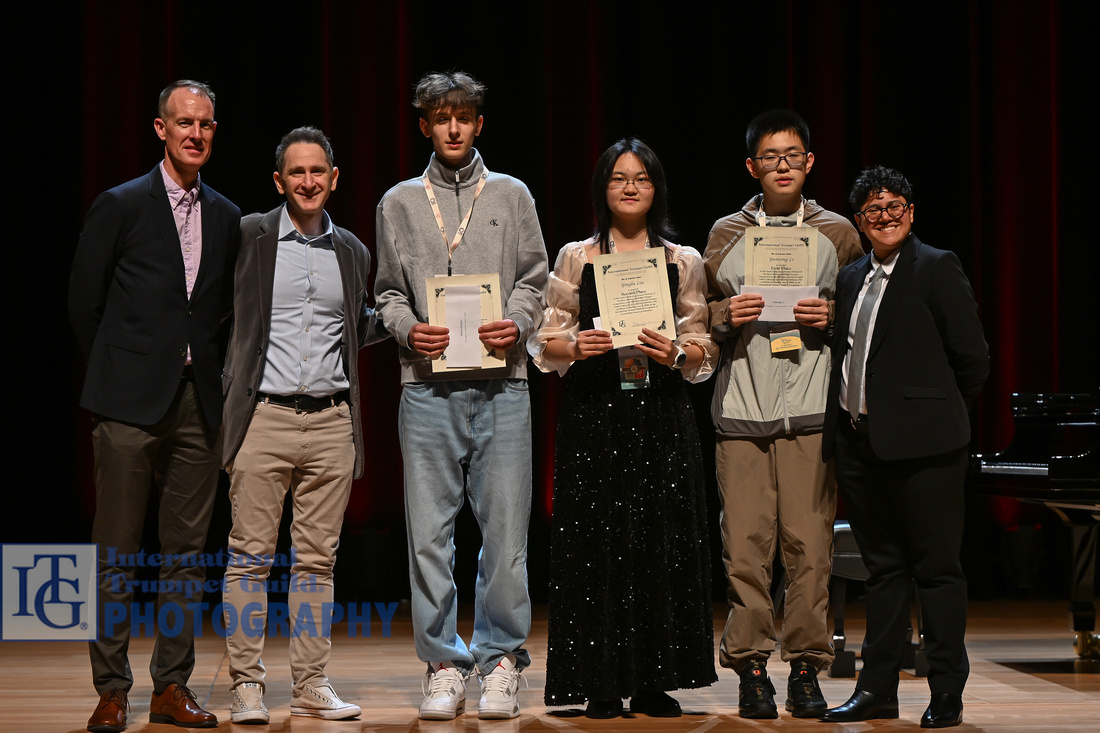

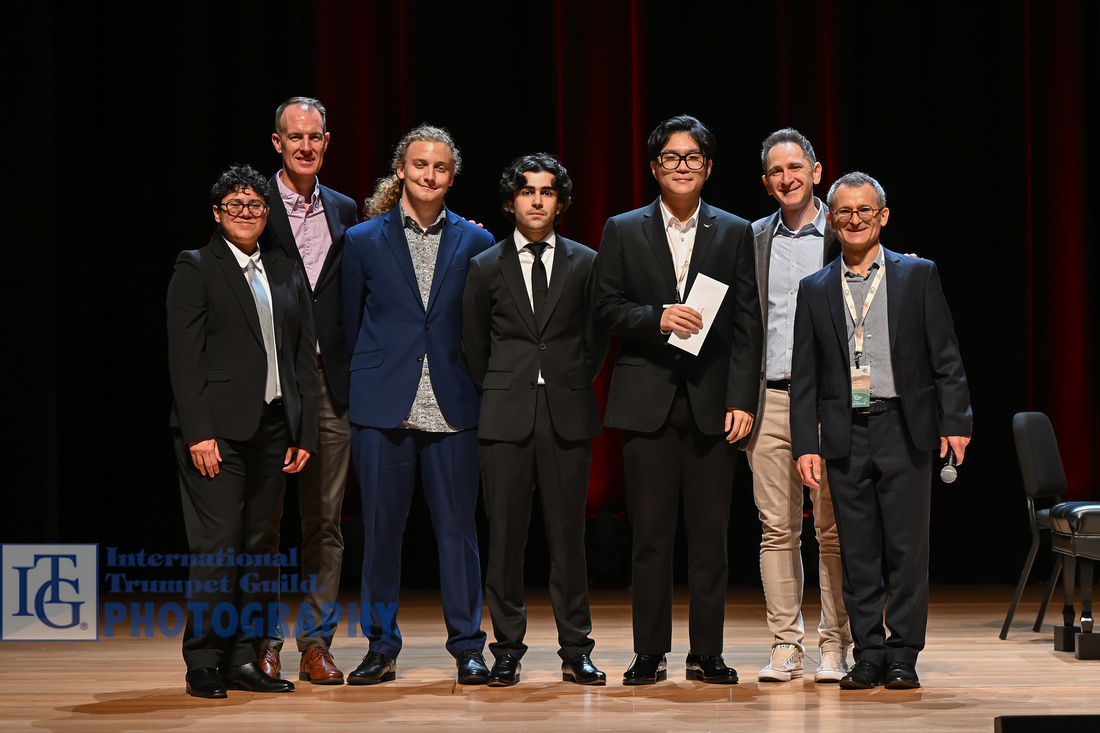

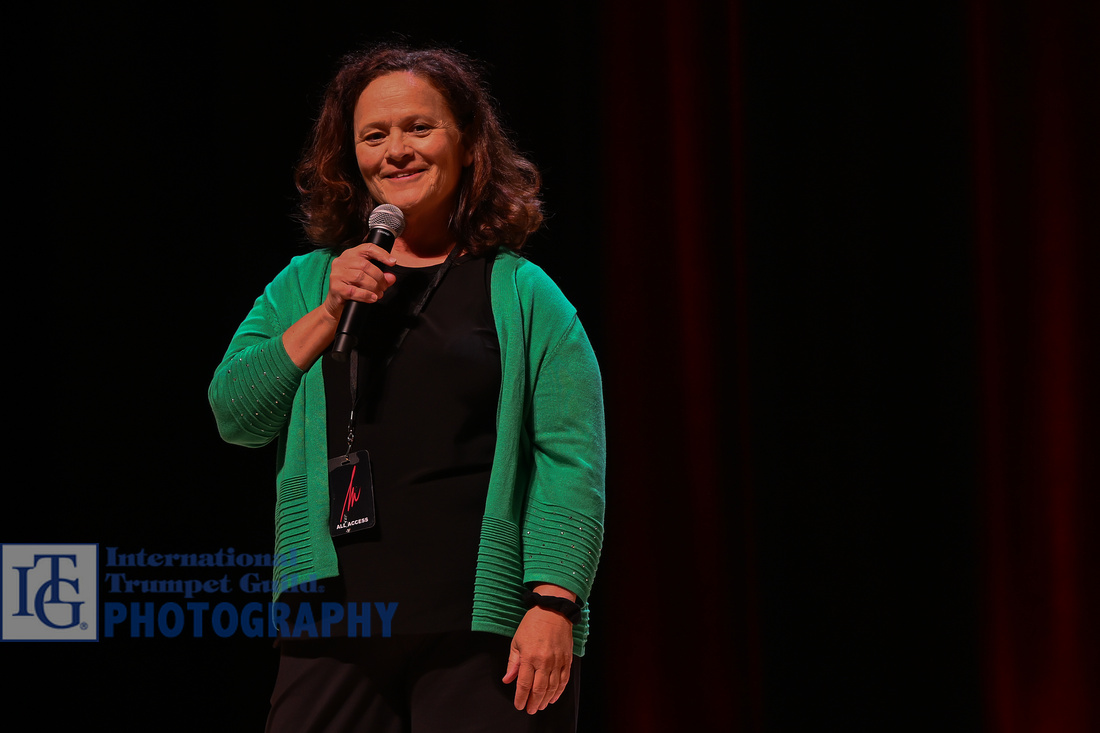

Håkan Hardenberger and his long-time collaborator, Roland Pontinen, took the stage, opening with Enescu’s “Legende.” The performance was seamless, Hardenberger’s dynamic control and intonation was impeccable. This was followed by Staffan Storm’s formidable “Three Autumns.” Clocking in at nearly twenty minutes, the three-movement work featured delicate muted passages, acrobatic leaps matching the piano writing perfectly, and moments of placid, relaxed moods punctuated by dramatic writing for both performers. In numerous moments that seemed absent of pulse, the coordination between Hardenberger and Pontinen appeared organic; lines that seemed unrelated would coalesce momentarily - suddenly - and then part ways again. The relatively slow and placid middle movement was a study in endurance, which Hardenberger somehow made sound easy.


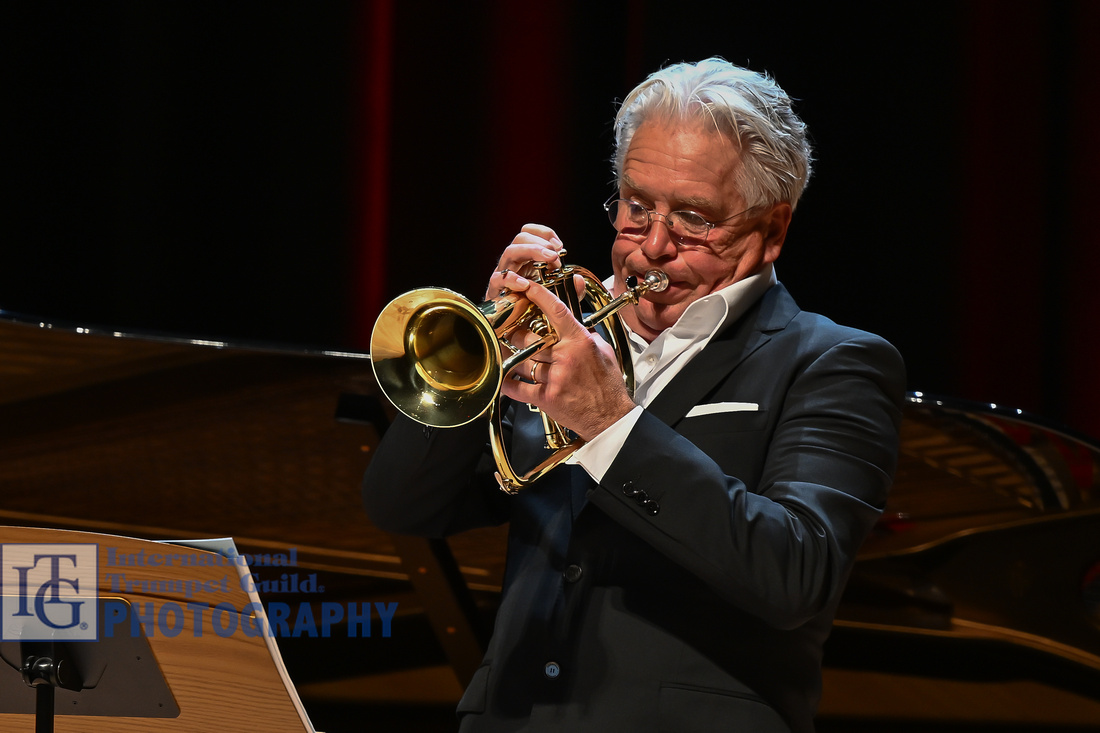

The second half of the program consisted of shorter works, starting with Heinz Karl Gruber’s charming “Bossa Nova” and followed by the world premiere of Mark-Anthony Turnage’s “Autumn Aubade.” While the Gruber had the easy feel of a late-night jazz set, the Turnage would have served nicely as the “last call” tune in a smoky club in the 1950s. Performed on flugelhorn, the piece had a mysterious, weary quality with thin accompaniment and jazz ballad-style rubato and solo fills. This was followed by the second world premiere of the evening - Roland Pontinen’s “Bluebird Dream.” Pontinen’s scoring of Harmon mute above sparse, light piano motives had the impressionistic flavor of Claude Debussy. Though no program notes were offered, the sounds of raindrops, chirping birds, and gently flowing water were easy to catch. A brisk “Rondo for Lifey” lightened the mood before Pontinen took the stage for a solo set of two Preludes of Frederic Chopin, followed by his own “Prelude d’automne,” all of which he performed with fluidity, nuance, and considerable grace.
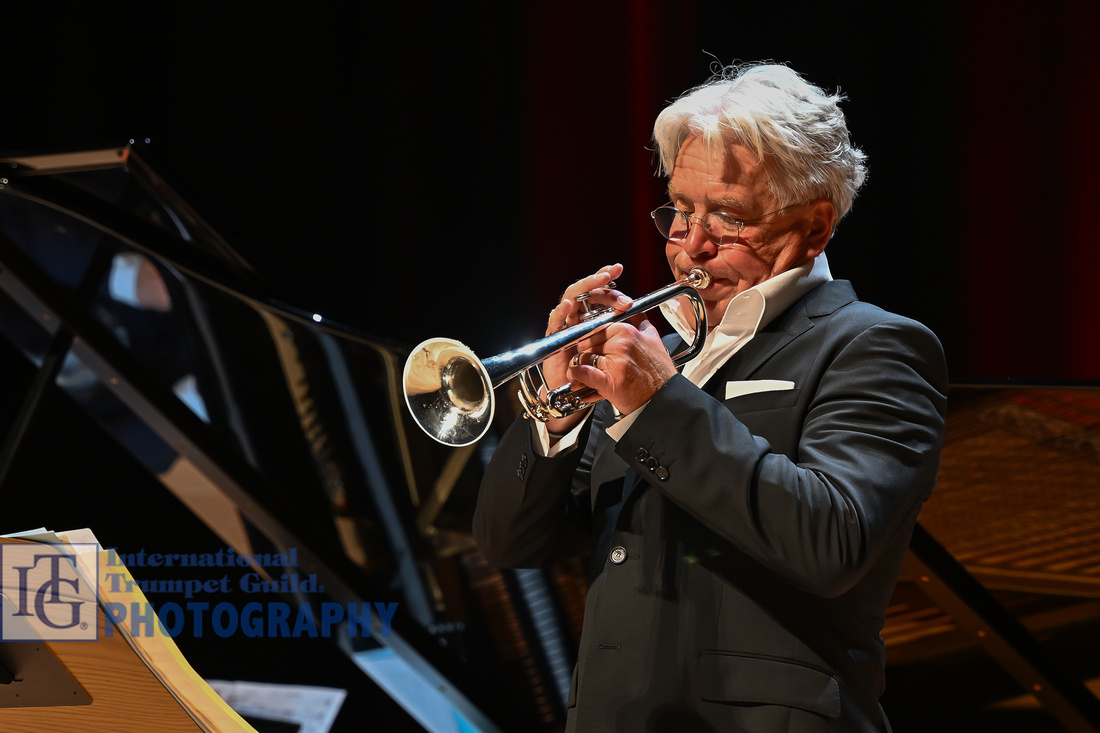

Hardenberger returned to the stage for the final work on the program, Florent Schmitt’s Suite for Trumpet and Piano. Hardenberger handled the angular, energetic, and highly technical outer movements with ease while the pensive middle movement once again highlighted his remarkable control and apparently limitless endurance. Since he seemed to have much more in “the tank,” the duo returned for two encores, the first a rendition of “Nature Boy” in a placid, understated style, reminiscent of Chet Baker. The second encore was Pontinen’s “Girl from Brazil,” also in the jazz ballad vein and performed on request from Conference Director Rebecca Wilt. Due to the generous support of the Puente de Maravillas Foundation, the Conference attendees were treated to a truly astounding concert! (Daniel Kelly)
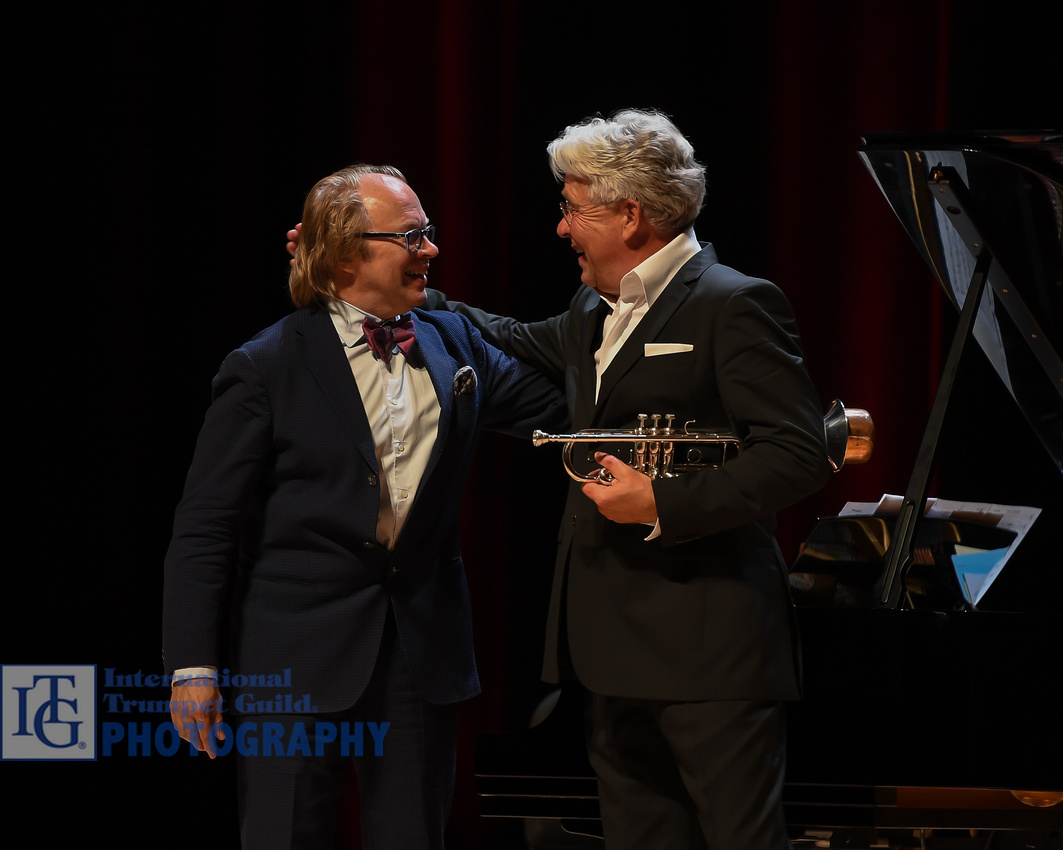

Jam Session with Bria Skonberg
To conclude the fourth day of the 2024 ITG Conference, Bria Skonberg hosted the late-night jam session. The combo for this evening’s session consisted of Joel Taylor on drums, Quinn Johnson on piano, and Kevin Axt on bass. Groups of two to four trumpet players would take the stage to play a piece of their choice, which showcased their individual musical abilities. Each selection allowed all instruments to solo over the combo, sharing their beautiful and complex musical ideas. To conclude each piece, the trumpet sections all joined together and improvised over each other. Some of the pieces that were selected for the evening consisted of Benny Golson’s “Stablemates,” Hoagy Carmichael’s “Rockin Chair,” Billy Reid’s “I’ll Close My Eyes,” and Johnny Mercer’s “I Thought About You.” The uplifting and inspiring jam session drew the evening to a successful close. (Maryna Pohlman)
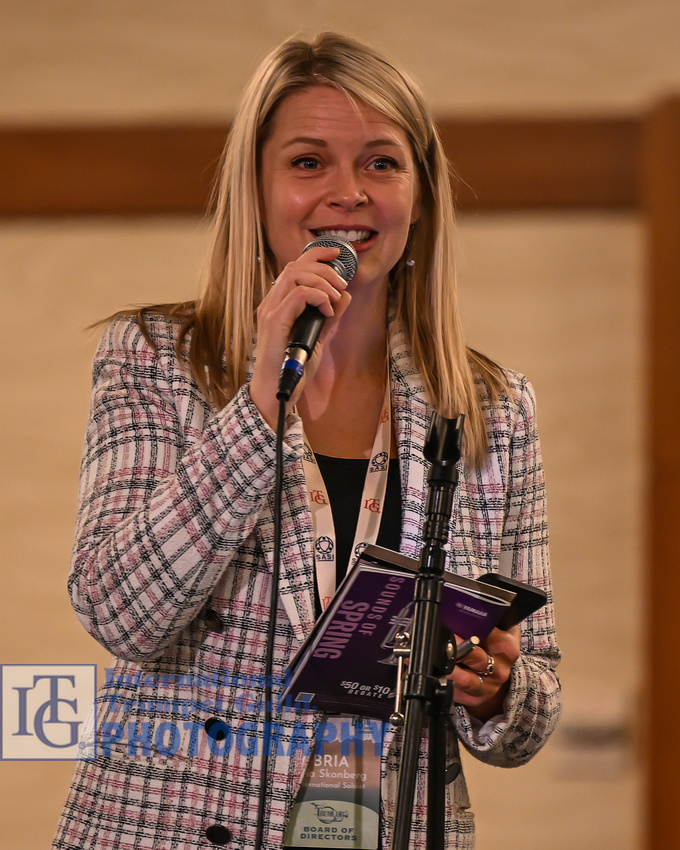

Click here for more photos from the ITG Conference